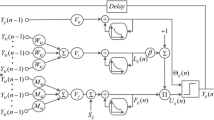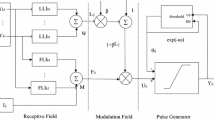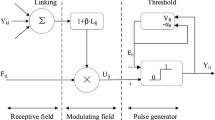Abstract
The pulse-coupled neural network (PCNN) is widely used in digital image processing. Although existing studies mainly analyze the network from the time-domain perspective, there are still some limitations in revealing the characteristics of network. In this paper, from the iterative equations of PCNN, the expressions for the firing time and firing interval of neuron are given. Spectrum for the dynamic threshold subsystem and firing subsystem of PCNN is given by using the Z-transform and the discrete Fourier transform, and the effects of different parameters \(a_{E}\), \(V_{E}\) and \(K\) on the frequency-domain characteristics of the two subsystems are analyzed. The edge detection phenomenon exhibited by the iterative output of the PCNN is explained by analyzing the effect of the neighbor coupling state on the firing time and interval. Finally, the correctness of the analysis is validated by simulation experiments, which provides a new idea for the further study into the characteristics of PCNN.





















Similar content being viewed by others
Data availability
The study's data are available publicly and can be easily accessed from the internet.
References
Eckhorn R, Reitboeck HJ, Arndt MT et al (1990) Feature linking via synchronization among distributed assemblies: Simulations of results from cat visual cortex. Neural Comput 2(3):293–307. https://doi.org/10.1162/neco.1990.2.3.293
Johnson JL, Padgett ML (1999) PCNN models and applications. IEEE Trans Neural Networks 10(3):480–498. https://doi.org/10.1109/72.761706
Basar S, Waheed A, Ali M et al (2022) An efficient defocus blur segmentation scheme based on hybrid LTP and PCNN. Sensors 22(7):2724. https://doi.org/10.3390/s22072724
Biswas B, Ghosh SK, Ghosh A (2020) A novel CT image segmentation algorithm using PCNN and Sobolev gradient algorithms in GPU frameworks. Pattern Anal Appl 23:837–854. https://doi.org/10.1007/s10044-019-00837-9
Xiangyu DENG, Yide MA, Min DONG (2016) A new adaptive filtering algorithm for removing salt and pepper noise based on multilayered PCNN. Pattern Recogn Lett 79:8–17. https://doi.org/10.1016/j.patrec.2016.04.019
Jiang L, Zhang D, Che L (2021) Texture analysis-based multi-focus image fusion using a modified pulse burst-coupled neural network (PCNN). Signal Process Image Commun 91:116068. https://doi.org/10.1016/j.image.2020.116068
Liu L, Huo J (2023) PCNN Model guided by saliency mechanism for image fusion in transform domain. Sensors 23(5):2488. https://doi.org/10.3390/s23052488
Huang C, Tian G, Lan Y et al (2019) A new pulse burst coupled neural network (PCNN) for brain medical image fusion empowered by shuffled frog leaping algorithm. Front Neurosci 13:210. https://doi.org/10.3389/fnins.2019.00210
Lou L, Chang XW (2021) Edge detection and location of seismic image based on PCNN[C]. J Phys Conf Series 1894(1):012096. https://doi.org/10.1088/1742-6596/1894/1/012096
Shi K, Heng S, Wang X et al (2022) An oxide based spiking thermoreceptor for low-power thermography edge detection. IEEE Electron Device Lett 43(12):2196–2199. https://doi.org/10.1109/LED.2022.3215693
Chabi Adjobo E, Sanda Mahama AT, Gouton P et al (2022) Towards accurate skin lesion classification across all skin categories using a pcnn fusion-based data augmentation approach. Computers 11(3):44. https://doi.org/10.3390/computers11030044
Xiang R (2018) Image segmentation for whole tomato plant recognition at night. Comput Electron Agric 154:434–442. https://doi.org/10.1016/j.compag.2018.09.034
Xie W, Li Y, Ma Y (2016) PCNN-based level set algorithm of automatic mammographic image segmentation. Optik 127(4):1644–1650. https://doi.org/10.1016/j.ijleo.2015.09.250
Tian-jian L (2020) High-resolution SAR images segmentation using NSCT denoising and QIGA based parameters selection of PCNN model. Multimed Tools Appl. https://doi.org/10.1007/s11042-020-09536-8
Zhang D, Mabu S, Hirasawa K (2011) Image denoising using pulse burst coupled neural network with an adaptive Pareto genetic algorithm. IEEJ Trans Electr Electron Eng 6(5):474–482. https://doi.org/10.1002/tee.20684
Di J, Yin S, Lian J (2022) Improved dual-channel PCNN multi-focus RGB image fusion based on NSST. Appl Res Comput 39(01):308–311. https://doi.org/10.19734/j.issn.1001-3695.2021.05.0208
Panigrahy C, Seal A, Mahato NK (2020) Fractal dimension based parameter adaptive dual channel PCNN for multi-focus image fusion. Optics Lasers Eng. https://doi.org/10.1016/j.optlaseng.2020.106141
Zhaobin W, Shuai W, Lijie G (2018) Novel multi-focus image fusion based on PCNN and random walks. Neural Comput Appl. https://doi.org/10.1007/s00521-016-2633-9
Deng X, Yan C, Ma Y (2019) PCNN mechanism and its parameter settings. IEEE Trans Neural Netw Learn Syst 31(2):488–501. https://doi.org/10.1109/TNNLS.2019.2905113
Deng XY, Lü YH, Chen Y (2022) Frequency-domain characteristics analysis of non-coupled PCNN. Comput Eng 48(6):213–221. https://doi.org/10.19678/j.issn.1000-3428.0061296
Deng X (2012) Image edge detection method based on PCNN. Autom Instrument. https://doi.org/10.3969/j.issn.1001-9227.2012.03.054
Deng X, Ma Y (2012) PCNN model automatic parameters determination and its modified model. Acta Electron Sin 40(5):955–964. https://doi.org/10.3969/j.issn.0372-2112.2012.05.015
Xiangyu DENG, Yide MA (2014) PCNN model analysis and its automatic parameters determination in image segmentation and edge detection. Chin J Electron 23(01):97–103. https://doi.org/10.3233/JAE-131740
Liu Y, Cheng MM, Hu X et al. (2017) Richer convolutional features for edge detection. In: Proceedings of the IEEE Conference on Computer Vision and Pattern Recognition. 3000–3009. https://doi.org/10.1109/CVPR.2017.622
Abdou IE, Pratt WK (1979) Quantitative design and evaluation of enhancement/thresholding edge detectors. Proc IEEE 67(5):753–763. https://doi.org/10.1109/PROC.1979.11325
Hodson TO, Over TM, Foks SS (2021) Mean squared error, deconstructed. J Adv Model Earth Syst 13(12):e2021MS002681. https://doi.org/10.1029/2021MS002681
Huynh-Thu Q, Ghanbari M (2012) The accuracy of PSNR in predicting video quality for different video scenes and frame rates. Telecommun Syst 49:35–48. https://doi.org/10.1007/s11235-010-9351-x
Funding
This work was supported by the National Natural Science Foundation of China (No. 61961037) and the Industrial Support Plan of Education Department of Gansu Province (No. 2021CYZC-30).
Author information
Authors and Affiliations
Contributions
H did the whole research and wrote the manuscript under the supervision of D, the major supervisor, and Y, the co-supervisor. All authors read and approved the final manuscript.
Corresponding author
Ethics declarations
Conflict of interest
No conflicts of interest are disclosed by the authors.
Ethical approval.
The research is compatible with ethical standards.
Additional information
Publisher's Note
Springer Nature remains neutral with regard to jurisdictional claims in published maps and institutional affiliations.
Rights and permissions
Springer Nature or its licensor (e.g. a society or other partner) holds exclusive rights to this article under a publishing agreement with the author(s) or other rightsholder(s); author self-archiving of the accepted manuscript version of this article is solely governed by the terms of such publishing agreement and applicable law.
About this article
Cite this article
Deng, X., Huang, X. & Yu, H. Frequency-domain characteristic analysis of PCNN. J Supercomput 80, 8060–8093 (2024). https://doi.org/10.1007/s11227-023-05750-x
Accepted:
Published:
Issue Date:
DOI: https://doi.org/10.1007/s11227-023-05750-x




